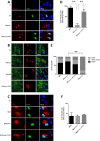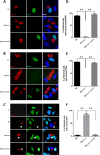A Novel Secreted Protein, MYR1, Is Central to Toxoplasma's Manipulation of Host Cells
- PMID: 26838724
- PMCID: PMC4742717
- DOI: 10.1128/mBio.02231-15
A Novel Secreted Protein, MYR1, Is Central to Toxoplasma's Manipulation of Host Cells
Erratum in
-
Erratum for Franco et al., "A Novel Secreted Protein, MYR1, Is Central to Toxoplasma's Manipulation of Host Cells".mBio. 2018 Oct 2;9(5):e01869-18. doi: 10.1128/mBio.01869-18. mBio. 2018. PMID: 30279290 Free PMC article. No abstract available.
Abstract
The intracellular protozoan Toxoplasma gondii dramatically reprograms the transcriptome of host cells it infects, including substantially up-regulating the host oncogene c-myc. By applying a flow cytometry-based selection to infected mouse cells expressing green fluorescent protein fused to c-Myc (c-Myc-GFP), we isolated mutant tachyzoites defective in this host c-Myc up-regulation. Whole-genome sequencing of three such mutants led to the identification of MYR1 (Myc regulation 1; TGGT1_254470) as essential for c-Myc induction. MYR1 is a secreted protein that requires TgASP5 to be cleaved into two stable portions, both of which are ultimately found within the parasitophorous vacuole and at the parasitophorous vacuole membrane. Deletion of MYR1 revealed that in addition to its requirement for c-Myc up-regulation, the MYR1 protein is needed for the ability of Toxoplasma tachyzoites to modulate several other important host pathways, including those mediated by the dense granule effectors GRA16 and GRA24. This result, combined with its location at the parasitophorous vacuole membrane, suggested that MYR1 might be a component of the machinery that translocates Toxoplasma effectors from the parasitophorous vacuole into the host cytosol. Support for this possibility was obtained by showing that transit of GRA24 to the host nucleus is indeed MYR1-dependent. As predicted by this pleiotropic phenotype, parasites deficient in MYR1 were found to be severely attenuated in a mouse model of infection. We conclude, therefore, that MYR1 is a novel protein that plays a critical role in how Toxoplasma delivers effector proteins to the infected host cell and that this is crucial to virulence.
Importance: Toxoplasma gondii is an important human pathogen and a model for the study of intracellular parasitism. Infection of the host cell with Toxoplasma tachyzoites involves the introduction of protein effectors, including many that are initially secreted into the parasitophorous vacuole but must ultimately translocate to the host cell cytosol to function. The work reported here identified a novel protein that is required for this translocation. These results give new insight into a very unusual cell biology process as well as providing a potential handle on a pathway that is necessary for virulence and, therefore, a new potential target for chemotherapy.
Copyright © 2016 Franco et al.
Figures









References
-
- Yamamoto M, Standley DM, Takashima S, Saiga H, Okuyama M, Kayama H, Kubo E, Ito H, Takaura M, Matsuda T, Soldati-Favre D, Takeda K. 2009. A single polymorphic amino acid on Toxoplasma gondii kinase ROP16 determines the direct and strain-specific activation of Stat3. J Exp Med 206:2747–2760. doi:10.1084/jem.20091703. - DOI - PMC - PubMed
-
- Jensen KD, Hu K, Whitmarsh RJ, Hassan MA, Julien L, Lu D, Chen L, Hunter CA, Saeij JP. 2013. Toxoplasma gondii rhoptry 16 kinase promotes host resistance to oral infection and intestinal inflammation only in the context of the dense granule protein GRA15. Infect Immun 81:2156–2167. doi:10.1128/IAI.01185-12. - DOI - PMC - PubMed
Publication types
MeSH terms
Substances
Grants and funding
- R01 AI73756/AI/NIAID NIH HHS/United States
- P30 NS069375/NS/NINDS NIH HHS/United States
- P01 HG000205/HG/NHGRI NIH HHS/United States
- F31 AI120649/AI/NIAID NIH HHS/United States
- K08 AI102946/AI/NIAID NIH HHS/United States
- T32 AI007328/AI/NIAID NIH HHS/United States
- R01 AI073756/AI/NIAID NIH HHS/United States
- S10 RR025518/RR/NCRR NIH HHS/United States
- R01 AI112962/AI/NIAID NIH HHS/United States
- NS069375/NS/NINDS NIH HHS/United States
- T32 AI007290/AI/NIAID NIH HHS/United States
- R21 AI112962/AI/NIAID NIH HHS/United States
- S10RR025518-01/RR/NCRR NIH HHS/United States
- K08AI102946-01/AI/NIAID NIH HHS/United States
- P01-35HG000205/HG/NHGRI NIH HHS/United States
- R01 AI074953/AI/NIAID NIH HHS/United States
- F32 HG000205/HG/NHGRI NIH HHS/United States
LinkOut - more resources
Full Text Sources
Other Literature Sources
Research Materials
